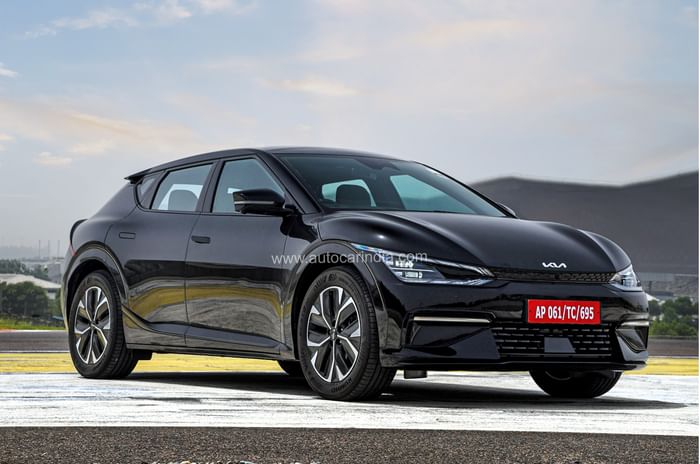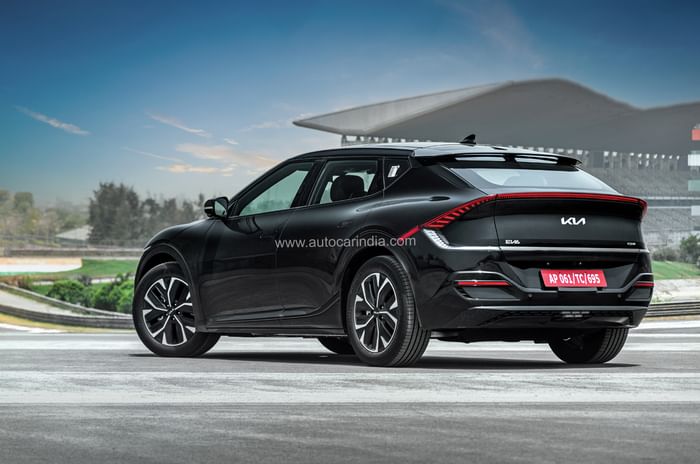While Hyundai India launched its electric Kona in 2019, Kia India did not bring in its sister product, the Niro EV. Instead, it now joins the EV race with its flagship model, the EV6. Built on the firm’s Electric Global Modular Platform (E-GMP) – that’s shared with the Hyundai Ioniq 5 – the EV6 is a born-electric vehicle built without the limitations of also having to offer an internal combustion engine. Thus, Kia’s EV6 shows all that the modern-everyday EV experience has in store for us.
One look at the exterior and you know this is something different, and like the Jaguar i-Pace – incidentally built on a heavily modified ICE platform – the EV6 is all swoopy and falls somewhere between a hatch and an SUV. While the Brit sports a large grille and traditional head and tail-lights for familiarity sake, the Korean goes quite radical.
Kia EV6 exterior: distinctive and futuristic
The headlamp units are enveloped inside large DRLs and the top and bottom are styled to look like a mirror image of one another. It’s quite a convincing look and the whole unit looks very cool and striking. Below the clam shell bonnet is a narrow faux grille, while the actual air intake is situated at the lower portion of the bumper which channels air for battery cooling and the HVAC system.

In profile the EV6 is smooth and flowing, and at the top, the roofline blends into a spoiler that channels air above and below its surface while sprouting mini wings on each side, all aiding aero efficiency. Also in the interest of aero efficiency, the 19-inch alloy wheels have a lot of surface area closed off, giving you only a peak at the disc brakes and calipers behind. Overall, the EV6 has a 0.28 coefficient of drag which is lower than the i-Pace’s 0.29.

The door handles are flush units, and at the bottom, a character line flows across both doors and then rises sharply to visually merge into the very dramatic tail-light unit that stretches right across the rear. The slim unit looks striking and sharp and is mirrored by the turn signal indicators and the chrome trim below. The whole effect is quite vivid and is easily the defining part of the EV6’s style.
Kia EV6 interior: ample space
Unlike the exterior, with the interior styling and layout, Kia has taken a more familiar route. The EV6’s insides aren’t like the other born-electric EVs, say the Tesla’s, or even its sibling, the Hyundai Ioniq 5. Instead of a radical layout, however, you get a very practical interior with a good dose of innovation, especially with regards to storage spaces, which are much larger and in places you wouldn’t expect. For example, a huge cubby below a floating centre console that easily holds a large handbag. The storage below the centre armrest is also quite deep and the glove box is large, all thanks to a flat floor and the HVAC system being moved further front – due to the absence of an engine.
At 4,695mm in length and 1,890mm in width, the EV6 is large; incidentally, the dimensions are identical to the XUV700. Its 2,900mm wheelbase is also larger than the Mahindra’s 2,750mm, thus expectedly, space inside is ample. At the rear, sitting three abreast is comfortable and the centre passenger won’t have a floor tunnel to contend with. Legroom is also very good even with the front seats adjusted for taller occupants.
The seating position, however, isn’t as comfortable as the dimensions would indicate. With the battery pack below, the floor is quite high and in combination with the low roof you are sat in a knees-up position to have enough headroom. You also can’t really extend your feet forward as there isn’t enough room below the front seats.
Seating at the front, though, is just fine. There’s ample space to stretch your legs out and my favourite bit about the car is the neat party trick that both front seats have. At the touch of a button, the seat back reclines massively, while the base tilts upward moving you into a zero-gravity position, which is really nice and comfy. Waiting chauffeurs or parents waiting to pick up their children from school will approve.
Boot space is also large at 520 litres, though the high floor means you’ll have to haul your bags in. With levers in the boot, you can also flip the rear seats down to extend luggage space, and the centre armrest also has a ski-through flip down for long and slimmer luggage. Besides this, there’s storage in the front with the AWD version, giving you 20 litres, while the RWD versions have a larger 52-litre storage bay.
Kia EV6 equipment and features: typically Kia, well equipped
The interior fit and finish is good and, on the whole, it feels premium. The dark theme works well and the dashboard and centre console have a nice black and grey patterned finish to them, and in a nod to sustainability, the floor mats and door pads are made of recycled materials. The EV6 has 64-colour ambient lighting in the doors, floor and in a neat pattern across the dash too. Other equipment includes a sunroof – but not a panoramic one that most will expect – ventilated seats, 360-deg camera, a wireless phone charger, USB slots at the front and back as well as a 3-pin AC power outlet below the rear seats to plug in something like a laptop. It offers a connected car experience, too.
Sound is courtesy a 14-speaker Meridian system and the EV6 has a very cool curved display panel that houses two 12.3-inch screens. While we didn’t get time to play around with the system, initial touch response was good and the layout quite intuitive. There’s also Apple CarPlay and Android Auto, though through wired connection only.
Interestingly, the HVAC and infotainment system share a touch panel and you have to toggle between modes (HVAC-Infotainment) to access their functions. It’s innovative, but not really safe or easy to use as you have to take your eyes off the road to see what mode the panel is in, then toggle it if needed and then input your command. The driver has an HUD with a good level of info displayed and the instruments screen can also be customised a bit, however, none of the options have a dial display.
In terms of safety equipment, the EV6 comes with ADAS with all the bits like lane keep assist and emergency braking. Needless to say, at the F1 track this was not something we could try out. As for the airbag count, it stands at eight, with two being side-centre bags to prevent front occupants striking each other.
Kia EV6 battery, charging and motors: super-fast charging capability
While the EV6 will be available in rear-wheel-drive and all-wheel-drive options, both will be powered by a 77.4kWh lithium-ion battery set-up. The EV6 can accept a very fast 350kW DC charge, which will see the battery go from 10 to 80 percent in just 18 minutes, and on a 50kW fast charger, the battery will take 73 minutes for the same level. For home charging, the Kia EV6 comes with a 22kW wall box charger as standard, though charging times for this have not been released.
For now, Kia has not released the ARAI-certified range, however, the international WLTP range stands at 528km. The EV6 battery can also power an external load and has a dedicated socket at the rear, so, for instance, it can run some camping equipment or even a refrigerator in a power cut.
On the RWD EV6, the motor makes 229hp and a max of 350Nm of torque, while on the AWD version, the motors put out a combined 325hp and 605Nm of torque. It was the latter that we drove, and even out on an F1 track, it really impressed us.
Kia EV6 performance: super quick, super strong
I’ve been fortunate enough to drive a few cars on the Buddh F1 circuit and, with the exception of the really quick supercars, all others – including some sports and muscle cars – feel quite out of their element on the long and wide track designed for F1 speeds. The EV6, though, really surprises. It’s quick, claimed 0-100kph time stands at 5.2 secs, but what’s really remarkable is that after you cross the 100kph mark, the build-up in speed is still strong.
Typically, EVs are lightning quick off the line and then the build-up in pace tapers soon. The Kia EV6 is also quick initially, and impressively, it really stands apart with a strong and linear acceleration pretty much all the way to its 192kph limited top speed. So quick and rapid is the build-up that we hit max velocity, gunning it from a standing start on the long back straight. There are also three drive modes – Eco, Normal and Sport – and all have a very distinct feel between them, so it will be interesting to see how they are out in the real world.
Like the acceleration, handling too is equally impressive; the way it goes around corners is simply brilliant, the EV6 changes direction in a manner that belies its near two-tonne weight and grip from the 235 section tyres is very good. Yes, on a track, you can push it to the limits of its body roll, but in real world corners and speeds, body roll will be well contained. Steering weight is also good, though given its eager manners, I would have liked some more feel and feedback at the wheel.
The brakes too have different modes; Normal and Sport, with the latter providing a more eager bite. The system works well and hard braking is not a problem at all. Under normal braking, too, the pedal feel is nice and natural and you can’t really tell when the wheel brakes kick in to supplement motor braking. As with most other EVs, the EV6 uses motor braking (regen), along with the regular wheel brakes, to bring the car to a halt, and while the EV6 has various regen modes it also has an auto mode where the car will vary the level depending on your driving style. Like a few other EVs, there is also a single pedal driving mode where braking is strong enough to slow you down on releasing the throttle, even bringing you to a complete halt. This too works well and we’ll know just how good it is once we have it in real traffic.
Kia EV6 price and verdict: should you buy one?
Also See:




